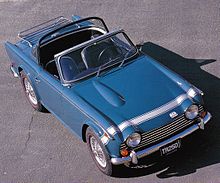TR2
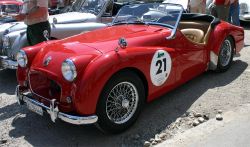 The Triumph TR2 (TRiumph 2 litre sports) was built between 1953 and 1955 by the Standard Motor Company in the United Kingdom, during which time 8,636 cars were produced. The DVLA revealed in 2002 that only 517 examples of this car remain on UK roads.
The Triumph TR2 (TRiumph 2 litre sports) was built between 1953 and 1955 by the Standard Motor Company in the United Kingdom, during which time 8,636 cars were produced. The DVLA revealed in 2002 that only 517 examples of this car remain on UK roads.
The car used a twin SU carburetor version of the 1991 cc four cylinder Standard Vanguard engine tuned to increase its output to 90 bhp (67 kW).
The body was mounted on a substantial separate chassis with coil-sprung independent suspension at the front and a leaf spring live axle at the rear. Either wire or disc wheels could be supplied. The standard transmission was a four speed manual unit but overdrive was available on top gear as an option. Lockheed drum brakes were fitted all round.
Performance data
A car with overdrive tested by The Motor magazine in 1954 had a top speed of 107.3 mph (172.7 km/h) and could accelerate from 0-60 mph (97 km/h) in 12.0 seconds. A fuel consumption of 34.5 miles per imperial gallon (8.19 L/100 km; 28.7 mpg-US) was recorded. The test car cost £900 including taxes. The overdrive option had added £56 to the total.
They also commented that it was the lowest price British car to be able to exceed 100 mph (160 km/h).
| Speed | Time | Time (overdrive version) |
|---|---|---|
| 0 – 30 mph (48 km/h) | 3.6 s | 4.0 s |
| 0 – 50 mph (80 km/h) | 8.2 s | 8.2 s |
| 0 – 60 mph (97 km/h) | 11.9 s | 12.0 s |
| 0 – 90 mph (140 km/h) | 31.5 s | 30.4 s |
TR3
 The Triumph TR3 was built between 1955 and 1957 by Standard-Triumph in the United Kingdom, during which time 13,377 cars were produced, of which 1286 were sold within the UK while the rest were exported mainly to the USA. As of 2002 there were only 893 registered TR3/3a’s on UK roads.
The Triumph TR3 was built between 1955 and 1957 by Standard-Triumph in the United Kingdom, during which time 13,377 cars were produced, of which 1286 were sold within the UK while the rest were exported mainly to the USA. As of 2002 there were only 893 registered TR3/3a’s on UK roads.
Although the car was usually supplied as an open two seater, an occasional rear seat and bolt on steel hard top were available as extras.
The car was powered by a 1991 cc straight-4 OHV engine which initially produced 95 bhp (71 kW; 96 PS) increasing to 100 bhp at 5000 rpm. The four speed manual transmission could be supplemented by an overdrive unit on the top three ratios electrically operated and controlled by a switch on the dash. In 1956 the front brakes changed from drum to disc becoming the first British series production car to be so fitted.
In 1957, it was replaced by an updated version, the TR3A.
TR3A
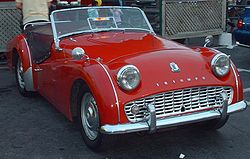 The TR3A was a minor update from the TR3. The updates included the new wide front grill, exterior door handles, lockable boot handle and came with a full tool kit as standard (this was an option on the TR3).
The TR3A was a minor update from the TR3. The updates included the new wide front grill, exterior door handles, lockable boot handle and came with a full tool kit as standard (this was an option on the TR3).
The total production run of the TR3A was 58,236. This makes it the third best selling TR after the TR6 and TR7. It is estimated that only 9,500 of the original 58,000 built survive in the world today.
The Triumph TR3 was the first production car to include standard disc brakes, which were continued on the TR3A. The car was known for its superior braking ability, making it an autocross favourite.
The TR3A is often seen in Vintage and Production racing today. The TR3A, despite being almost 50 years old, is still competitive in the E-Production class of SCCA (Sports Car Club of America).
In June 1977, Road & Track magazine published an article titled “Driving Impressions: TR3A & TR250” in its 30th anniversary issue. It published a 0-60 time of 12.0 seconds, power output of 100 bhp (75 kW) at 4800 rpm, observed curb weight of 2,090 lb (948 kg) and fuel consumption of 28 miles per imperial gallon (10 L/100 km; 23 mpg-US).
TR4
 The Triumph TR4 built in the United Kingdom by the Standard Triumph Motor Company and introduced in 1961. Code named “Zest” during development, the car was based on the chassis and drivetrain of the previous TR sports cars, but with a modern Michelotti styled body. 40,253 cars were built during production years. The TR4 proved very successful and continued the rugged, “hairy-chested” image that the previous TRs had enjoyed.
The Triumph TR4 built in the United Kingdom by the Standard Triumph Motor Company and introduced in 1961. Code named “Zest” during development, the car was based on the chassis and drivetrain of the previous TR sports cars, but with a modern Michelotti styled body. 40,253 cars were built during production years. The TR4 proved very successful and continued the rugged, “hairy-chested” image that the previous TRs had enjoyed.
Styling and coachwork
The new TR4 body style did away with the classical cutaway door design of the previous TRs to allow for wind-down (roll-up) windows (in place of less convenient side-curtains), and the angular rear allowed a boot (trunk) with considerable capacity for a sports car.
Advanced features included the first use of adjustable fascia ventilation in a production car and the option of a unique hard top that consisted of a fixed glass rear window (called a backlight) with an integral rollbar and a detachable, steel centre panel (aluminium for the first 500 units). This was the first such roof system on a production car and preceded by 5 years the Porsche 911/912 Targa, which has since become a generic name for this style of top.
On the TR4 the rigid roof panel was replaceable with an easily folded and stowed vinyl insert and supporting frame called a Surrey Top. The entire hard top assembly is often mistakenly referred to as a “Surrey Top”. In original factory parts catalogues the rigid top and backlight assembly is listed as the “Hard Top” kit. The vinyl insert and frame are offered separately as a “Surrey Top”.
Features such as wind-down windows were seen as a necessary step forward to meet competition and achieve good sales in the important US market, where the vast majority of TR4s were eventually sold. However, dealers had concerns buyers might not fully appreciate the new amenities so a special short run of TR3A (commonly called TR3″B”) were produced in 1961 and ’62.
Engineering
The pushrod 4 cylinder engine based on the early design of the Ferguson tractor engine, was continued from the earlier TR2/3 models, however the displacement was increased from 1991cc to 2138cc in the TR4 by using a larger diameter piston. Gradual improvements in the manifolds and cylinder head allowed for some improvements culminating in the TR4A model. Although, the 1991cc engine became a no-cost option for those cars destined to race in the under-two-liter classes of the day. Some cars were fitted with vane-type superchargers, as the three main bearing engine was liable to crankshaft failure if revved beyond 6,500 rpm. Superchargers allowed a TR4 to produce much more horse-power and torque at relatively modest revolutions. The standard engine produced 105 bhp (78 kW) SAE but supercharged and otherwise performance-tuned a 2.2 litre I4 version could produce in excess of 200 bhp (150 kW) at the flywheel. The TR4, in common with its predecessors, was fitted with a wet-sleeve engine, so that for competition use the engine’s cubic capacity could be changed by swapping the cylinder liners and pistons, allowing a competitor to race under different capacity rules (i.e. below or above 2 litres for example).
Other key improvements over the TR3 included a wider track front and rear, slightly larger standard engine displacement, full synchromesh on all forward gears, and rack and pinion steering. In addition , the optional Laycock de Normanville electrically operated overdrive could now be selected for 2nd and 3rd gear as well as 4th, effectively providing the TR4 with a seven-speed manual close ratio gearbox.
TR4 were originally fitted with 15×4.5″ disk wheels. Optional 48 lace wire wheels could be ordered painted the same colour as the car’s bodywork (rare), stove-enamled (matte silver with chrome spinners, most common) or in matte or polished chrome finishes (originally rare, but now more commonly fitted). The most typical tyre originally fitted was 165×15 bias ply. In the US at one point, American Racing alloy (magnesium and aluminium) wheels were offered as an option, in 15×5.5″ or 15×6″ size. Tyres were a problem for original owners who opted for 48 spoke wire wheels, as the correct size radial ply tyre for the factory rims was 175×15, an odd sized tyre at the time that was only available from Michelin at considerable expense. The much more common 185×15 radials were too wide to be fitted safely. As a result, many owners had new and wider rims fitted and their wheels re-laced.
Sporting achievements
In America, the TR4 also saw a number of racing successes, primarily through the efforts of the Californian engineer Kas Kastner and his top driver, Bob Tullius, the TR4 in 1962 won the E Production national championship. The SCCA reclassified the car to D Production, and Tullius won that class title in 1963 and ’64. Soon after the TR4 was introduced Kas Kastner along with Mike Cook who was in the advertising department at Triumph in New York City convinced the company to provide three new TR4s to race in the 12 Hours of Sebring race in 1963. Beginning in Sept 1962 the cars were prepared in California where Kastner was Service Supervisor for Triumph. The cars were then flown to Florida for the endurance race in March on 1963. These cars were driven by Mike Rothschild and Peter Bolton from England, Bob Tullius, Charlie Gates, Ed Deihl, Bob Cole, Bruce Kellner and Jim Spencer and finished overall 22nd, 24th, and 35th of 65 entries, and 1st, 2nd and 4th in the 2.5 GT class. This was the beginning of the Triumph Competition Department which Kastner headed for several years subsequently and used to publicize and market the TR4. The next year a privateer TR4 finished dead last in the 1964 running of the Sebring 12-hour race and Kas Kastner returned to Sebring in 1966 with four carefully prepared TR4As, three of which finished winning the class. In 1966 at Sebring, Bob Tullius threw a piston in the most highly tuned car and did not finish. Perhaps the greatest racing victory for the TR4A was at Daytona where a Kastner prepared car driven by Charlie Gates won the 1965 SCCA D Modified Championship against Ferraris and other prepared race car exotics.
The TR4 continues to be raced in vintage sports car events and even won an SCCA class championship as late as 1991. In Australia the TR4 was a common site at hill-climb events and various club rallies and circuit racing events. In 1964 the factory sponsored Team Triumph entered 3 TR4’s in the Canadian Shell 4000 rally. These “works” cars were reportedly built with gussets on the chassis members and aluminum body panels to both strengthen and lighten the car. After import, the engines were prepared in New York by Kas Kastner where they were also fitted with lightweight magnesium wheels. Although they didn’t place well in the rally, the surviving cars have become quite valuable, one of which is owned by Neil Revington, the proprietor of Revington TR in the UK. Indeed, the TR4 became a celebrated rally car in Europe and the UK during early to mid-sixties, and various replicas are still campaigned by privateers in vintage rally events through Europe.
TR4A
In 1965, the TR4A with IRS or independent rear suspension superseded the TR4. Apart from the rear suspension, which used trailing arms and a differential bolted to the redesigned chassis frame and a number of small styling changes and refinements, the two models appear nearly identical. In fact, an estimated 25% of TR4As were not equipped with IRS, but instead reverted to a live axle design similar to the TR4, which was adapted to fit the new chassis.
Dové GTR4
 Perhaps the most rare production TR4 model is the Dové GTR4 (and GTR4A) — a TR4 rebuilt as a coupé by a specialist coachbuilder for the Dove dealership in Wimbeldon, London; only 43 were produced. The conversions were by Harrington Motor Bodyworks, mostly known for construction of the Harrington Alpine, a similarly converted Sunbeam Alpine. Although most were based on the TR4 model, the sales brochure pictures a TR4A version of these cars. The engines came with such period extras as a heater in the water jackets to assist early morning starts. Some were fitted with fully balanced motors by Jack Brabham Motors or Laystall Engineering in London, which was offered as an option in the sales catalogue. Two jump seats were placed behind the driver’s seat using identical materials to the originally equipped standard TR4. A wood-rimmed wheel with riveted perimeter was fitted to some models along with auxiliary lamps under the front bumper bars. A metallised identifying sticker with “Dové” on it was fitted to the glovebox lid. On the rear deck to the left below the lid, was another identifying badge with the Dové logo. The side window glasses were specially shaped with a flat top edge to fit the new roof line. Each Dové was an individual order and some variation occurred in each car. Tinted swing-down see-through acrylic sun visors were custom fitted. The aerodynamics of the Dové gave it good acceleration from 80 mph (130 km/h) to 100 mph (160 km/h) in comparison with the standard version of the car. They were originally conceived by L.F. Dove & Co. as their attempt to fill the GT category for Europe, hence the French nomenclature with an inflection at the end of the word Dové. The cars were priced at £1250, almost as much as a Jaguar E-Type, and as such were uncompetitive price-wise. One example was exported for sale through Australian Motor Industries in Melbourne, Australia. A road test of one of these cars was reported in Autocar magazine dated June 7, 1963. Up to a dozen of the cars are known to still exist.
Perhaps the most rare production TR4 model is the Dové GTR4 (and GTR4A) — a TR4 rebuilt as a coupé by a specialist coachbuilder for the Dove dealership in Wimbeldon, London; only 43 were produced. The conversions were by Harrington Motor Bodyworks, mostly known for construction of the Harrington Alpine, a similarly converted Sunbeam Alpine. Although most were based on the TR4 model, the sales brochure pictures a TR4A version of these cars. The engines came with such period extras as a heater in the water jackets to assist early morning starts. Some were fitted with fully balanced motors by Jack Brabham Motors or Laystall Engineering in London, which was offered as an option in the sales catalogue. Two jump seats were placed behind the driver’s seat using identical materials to the originally equipped standard TR4. A wood-rimmed wheel with riveted perimeter was fitted to some models along with auxiliary lamps under the front bumper bars. A metallised identifying sticker with “Dové” on it was fitted to the glovebox lid. On the rear deck to the left below the lid, was another identifying badge with the Dové logo. The side window glasses were specially shaped with a flat top edge to fit the new roof line. Each Dové was an individual order and some variation occurred in each car. Tinted swing-down see-through acrylic sun visors were custom fitted. The aerodynamics of the Dové gave it good acceleration from 80 mph (130 km/h) to 100 mph (160 km/h) in comparison with the standard version of the car. They were originally conceived by L.F. Dove & Co. as their attempt to fill the GT category for Europe, hence the French nomenclature with an inflection at the end of the word Dové. The cars were priced at £1250, almost as much as a Jaguar E-Type, and as such were uncompetitive price-wise. One example was exported for sale through Australian Motor Industries in Melbourne, Australia. A road test of one of these cars was reported in Autocar magazine dated June 7, 1963. Up to a dozen of the cars are known to still exist.
TR5
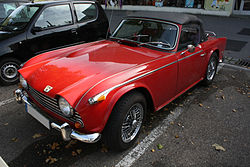 The Triumph TR5 was built for a 13 month period between August 1967 and September 1968 by the Triumph Motor Company in Coventry, United Kingdom.
The Triumph TR5 was built for a 13 month period between August 1967 and September 1968 by the Triumph Motor Company in Coventry, United Kingdom.
Visually identical to the Michelotti styled TR4, the TR5 hid the main differences under the body, and the most significant of these was the engine. The TR5 boasted a 2.5 litre straight 6 fuel injected engine developing around 150 bhp (112 kW). This engine was carried forward to the TR6.
At the time, fuel injection (or PI petrol injection, as it was sometimes called back then) was uncommon in road cars. So much so that Triumph claimed in their sales brochure that it was the “First British production sports car with petrol injection – PI”. This engine could propel the TR5 from 0 to 50 mph (80 km/h) in just 6.5 seconds, and on to a top speed of 125 mph (201 km/h).Road tests at the time got slightly different performance figures.
Standard equipment included front disc brakes, independent rear suspension, rack and pinion steering and a four speed gearbox. The available optional extras included overdrive, wire wheels and a hard top with detachable roof panel – known as the ‘Surrey Top’.
In 1968, the basic price of the TR5 in the UK was £1,260 including taxes, with wire wheels being another £38, overdrive £60 and a tonneau cover another £13.
The TR5 was produced in small numbers when compared with the later TR6, with just 2,947 units produced – the first car being assembled on 29 August 1967 and the last on 19 September 1968. Of these, 1,161 were destined for the UK market,[6] the remainder being LHD TR5s and going to France, Belgium and Germany amongst others. In a similar period 8,484 TR250s were built for the U.S market.[1] At the end of 2007, there were approximately 500 TR5s registered in the UK with the DVLA.
The TR250, built during the same period for the North American market, was nearly identical to the TR5. But, because of price pressures and emission regulations the TR250 was fitted with twin Zenith-Stromberg carburettors rather than the Lucas fuel injection system, and took 10.6 seconds to get to 60 mph (97 km/h).
A curious feature of the TR5/Lucas petrol injection system was the very frequent occurrence of an intermittent power failure when the fuel tank was no more than a quarter full. In order to provide fresh fuel at the distributor, free from overheating/soak, unused fuel was returned back to the tank where it entered very close to the high pressure fuel pump. When the fuel level fell below critical (about 3 gallons), sloshing would cause the pump to pick up a slightly aerated mixture which was sent to the fuel distributor. Unused fuel (still aerated) then passed back to the tank and was discharged close to the pump, a proportion of it being picked up and recycled to the distributor. As this cycle was repeated, gradually the volume of air in the pumped fuel reached a level where it began to affect the running of the engine. Adding as little as one gallon to the tank seemed to cure the problem which did not manifest itself on the similarly engined contemporary saloon.
TR6
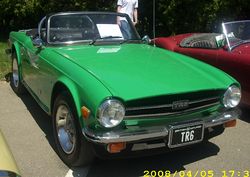 The Triumph TR6 (1969–76) was the successor to the TR5 and the best-seller of the TR range built by Triumph when production ended in July 1976. This record was then surpassed by the TR7. 94,619 TR6s were built, of which 86,249 found homes overseas, only 8,370 being sold in the UK.
The Triumph TR6 (1969–76) was the successor to the TR5 and the best-seller of the TR range built by Triumph when production ended in July 1976. This record was then surpassed by the TR7. 94,619 TR6s were built, of which 86,249 found homes overseas, only 8,370 being sold in the UK.
The bodywork closely resembled that of the previous model, the Triumph TR5, but the front and back ends were squared off, reportedly based on a consultancy contract involving Karmann.
All TR6 sports cars featured inline six-cylinder engines. For the US market the engine was carburetted, as had been the US-only TR250 model’s engine. For other world markets, including the United Kingdom, the TR6 was fuel-injected, therefore TR6PI (petrol injection), as had been the non-US market TR5. The Lucas mechanical fuel injection system helped the home-market TR6 produce 150 bhp (112 kW) at model introduction. Later the non-US TR6 variant was detuned to 125 bhp (93 kW) in order for it to be easier to drive, while the US-variant continued to be carburetted with a mere (but more reliable) 104 hp (78 kW).
The TR6 featured a four-speed manual transmission. An optional equipment overdrive unit was a desirable feature because it gave drivers close-gearing for aggressive driving, yet “long legs” for open motorways. TR6 also featured independent rear suspension, rack and pinion steering, fifteen inch (381 mm) wheels and tires, pile carpet on floors and trunk/boot, bucket seats, and a full complement of instrumentation. Braking was accomplished by disc brakes in the front; drum brakes in the rear. A factory steel hard top was optional. TR6 construction was fundamentally old-fashioned: the body was bolted onto a frame instead of the two being integrated into a unibody structure; the TR6 dashboard was wooden (plywood w/ veneer).
The TR6 can accelerate from zero to 60 mph in 8.2 seconds and has top speed of 120 mph (190 km/h).
TR7
 The Triumph TR7 was manufactured from September 1974 to October 1981 by the Triumph Motor Company (which was part of British Leyland) in the United Kingdom. It was initially produced at the Speke, Liverpool factory, moving to Canley, Coventry in 1978 and then finally to the Rover plant in Solihull in 1980. The car was launched in the United States in January 1975, with its UK home market debut in May 1976. The UK launch was delayed at least twice because of high demand for the vehicle in the US.
The Triumph TR7 was manufactured from September 1974 to October 1981 by the Triumph Motor Company (which was part of British Leyland) in the United Kingdom. It was initially produced at the Speke, Liverpool factory, moving to Canley, Coventry in 1978 and then finally to the Rover plant in Solihull in 1980. The car was launched in the United States in January 1975, with its UK home market debut in May 1976. The UK launch was delayed at least twice because of high demand for the vehicle in the US.
Design, features and variants
The car was characterized by its “wedge” shape, which was commonly advertised as: “The Shape of Things to Come”, and by a curved line in the bodywork sweeping down from the door area to the rear of the car. The design was penned by Harris Mann who also designed the wedge-shaped Leyland Princess. The car had an overall length of 160 inches (406 cm), width of 66 inches (168 cm), wheelbase of 85 inches (216 cm) and height of 49.5 inches (126 cm). The coupé had a kerbside weight of 2205 pounds (1000 kg). During development, the TR7 was referred to by the code name “Bullet”.
Power was provided by a 105 bhp (78 kW) (92 bhp (69 kW) in the North American version) 1998 cc 8-valve four-cylinder engine which shared the same basic design as the Triumph Dolomite Sprint engine mounted in-line at the front of the car. There were plans to directly use the Sprint engine 127 bhp (95 kW) in the TR7 and at least 25 pre-production cars were made in 1977 using the 1978 model year bodyshell. This model was getting ready for full production until the closure of the Speke Plant. These cars, of which several still exist in the UK, can be identified by a different chassis number to the production 8-valve model. Drive was to the rear wheels via a four-speed gearbox initially with optional five-speed manual gearbox or three-speed automatic from 1976. The front independent suspension used coil spring and damper struts and lower single link at the front, and at the rear was a four link system again with coil springs. There were front and rear anti roll bars, with disc brakes at the front and drums at the rear.
Various British Leyland vehicles were driven by the lead characters in the British secret agent television series The New Avengers, produced between 1976 and 1977. Amongst these was a yellow TR7 hardtop driven by the character Purdey. The car was immortalised as a children’s Dinky Toy and Revell construction kit.
In 1978 Coca-Cola and Levi’s ran promotional competitions with the top prizes being three TR7s in special red and white Coke livery. They also featured denim upholstery and genuine jean patch pockets on the door interiors. Also included were a 12V fridge in the boot and a TV in the glove compartment. Only one of these cars still exists.
For export to the US market, Triumph created a more powerful Triumph TR8 model in 1977/78, this was a TR7 with a 135 bhp (101 kW) 3.5 L Rover V8 engine. While some genuine TR8s stayed in Britain, these examples are exceedingly rare. Most TR8s went to the US, where they did not fare well due to both Triumph’s poor build quality at the time and the unusually strong pound which peaked at around $2.40 by 1980, making Triumphs fairly expensive compared to competitors.
In early 1979, Triumph belatedly introduced a convertible version, called the TR7 Drophead, which first went on sale in the US. The British market received it in early 1980. It is often forgotten that the convertible version of the original Harris Mann design was done by Michelotti. In the UK in 1980, the TR7 Drophead sold for £5,050, whilst the Coupé sold for £5,230.
British Leyland ran a team of TR7s in rally competitions from 1976 to 1980. These cars used the 16-valve Dolomite Sprint or Rover V8 engine and had disc brakes on all four wheels. They were reasonably successful on tarmac events but did not do so well on off road sections.
Quality problems
Quality problems tended to undermine the car’s image in the market place. In its Frankfurt Motor Show preview edition of September 1977, the motor magazine Auto, Motor und Sport reported that the engine of a TR7 press car had given up the ghost and “started to boil” while undergoing a maximum speed measurement exercise over a four kilometer stretch of track as part of a road test. At the time of the report the cause of the problem was still unknown; British Leyland technicians had already been investigating the car, without comment, for nineteen days.
The end
As part of a rationalisation introduced by BL boss Sir Michael Edwardes, the Triumph TR7 was axed in 1981.
Production volumes
In total, 112,368 hardtop TR7s were built with an additional 28,864 softtop/convertibles, and approximately 2,500 V8 engined TR8s.
Cancelled variants
While the TR7 was under development in the early 1970s, a 2+2 fastback derivative, codenamed Lynx was also planned. The Lynx had a wheelbase stretched by 12 inches (300 mm), the Rover V8 engine, with the rear axle from the Rover SD1. Scheduled for launch in 1978, the Lynx was cancelled when the Speke factory was closed.
In early 1979, a joint MG/Triumph project to produce a new sportscar based on the TR7 was started under the name Project Broadside. This was based on the TR7, with a wheelbase stretched by 5 inches (130 mm), with either an O-Series or Rover V8 engine, and both drophead and fastback body styles. Project Broadside was cancelled later in 1979, due to a lack of funding.
During the latter part of 1979, as an exercise in badge engineering, another MG version of the TR7 was developed under the codename Boxer as a potential replacement for the MGB. Various concepts were presented and ultimately a design from BL’s American headquarters at Leonia was accepted. Major changes to the standard TR7 Hardtop were the addition of a MG type grille to the nose panel, headlights similar to those of a Porsche 928 and a new tail panel with light units from a Rover SD1. The proposal was ultimately rejected on the grounds that the car was insufficiently different from the TR7.
